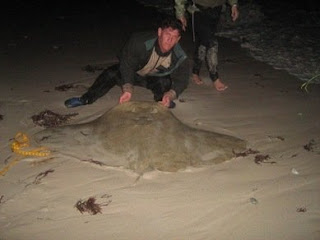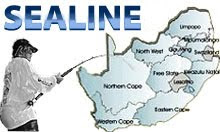8.5kg Cob caught at Marine Rd.
(www.rockandsurf.co.za)
So summer is on its way and our best fishing time and weather of the year is here, not in full force yet, but here. Guys have been slagging (catching/killing) the kob the last couple of weeks already, and catching sizer bronzies already and in Northwesterly winds, something which is unheard of. But like the saying goes "anything can happen when you have a line in the water!"
6.2kg Cob caught by Andre at Maccasser
(www.rockandsurf.co.za)
I for one went along the mountains for a throw, the water was looking awesome, nice colour and temp, thought i might go for a throw before heading off to a friends wedding. Through a couple of chokka and mackerel baits, and had no takers. A kid next to me had caught a couple of baby smooth hounds, so i decided to swim one, thought maybe i could get picked up my something fairly large, but had no takers. My swim bait was in for about 1 h 30min. and then i had to leave, i was pretty bummed about that, if i could have stuck around for a bit longer i am sure i would have been picked up. Anyway i chucked that small smoothie into my bait box and is now in my freezer at home, ready to be cut up and slid out this coming weekend for a bigass bronzie!!
Bronzie at Maccasser caught by Deon
Maccasser Bronze Whaler caught by Deon
In the picture below of Nikolay and his 2m (precaudel length) bronze whaler, if you take a closer look at the sea in the background, you'll notice that it is a greeny-brown colour and the sea is quite rough. That is the type of sea conditions that you are looking for when targeting these beasts, just find yourself a nice hole with some good colour, and put a bloody bait out, and you should be vas(stuck) into a bronzie in no time at all.
Nikolay with a 2m Bronze Whaler
(www.rockandsurf.co.za)










.jpg)









